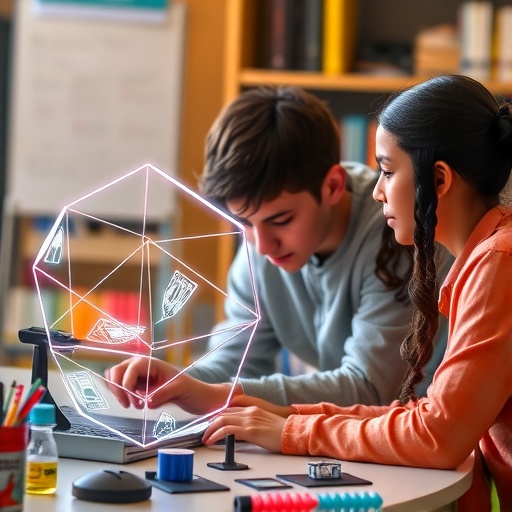In recent years, the field of education has been experiencing a paradigm shift, particularly in the domain of science, technology, engineering, and mathematics (STEM). Traditionally, STEM education has focused heavily on the technical and scientific aspects of learning. However, recent research highlights a growing trend that advocates for a more integrated and holistic approach, known as STEM education by incorporating aspects of society and human behavior. This transition indicates a significant evolution in educational methodologies and learning outcomes.
The research conducted by Chrysochou, Katsiampoura, and Skordoulis adds a critical dimension to the ongoing dialogue about STEM education. Their work urges educators and policymakers to broaden their perspective by incorporating considerations of sociocultural factors into the STEM framework. By transitioning from a strict focus on the technical elements of STEM to a more interdisciplinary approach, their findings promise to enhance student engagement and learning. It marks a departure from standardized teaching methods that have dominated classrooms for decades.
The authors propose that integrating the “S” for Society into STEM programs can lead to a richer learning experience for students. This approach not only prepares students to be adept in their respective disciplines but also instills in them a sense of social responsibility and awareness. By fostering connections between scientific subjects and societal implications, students can learn to apply their knowledge to real-world problems, creating a more resilient and educated workforce for the future.
Moreover, the incorporation of societal issues into STEM curricula has the potential to address pressing global challenges such as climate change, public health crises, and technological disruption. This is particularly relevant in today’s context, where the rapid advancement of technology often outpaces regulatory frameworks, creating ethical dilemmas that require immediate attention. By equipping students with a broader understanding of these challenges, educators can cultivate critical thinkers and innovative problem solvers who are better prepared for the complexities of modern society.
Through their research, Chrysochou and colleagues emphasize the importance of rethinking pedagogical strategies. Traditional learning models often compartmentalize subjects, which can lead to a disconnect between theoretical knowledge and practical application. The authors argue that by fostering interdisciplinary collaboration, educators can create rich frameworks that engage students on multiple levels. This sets the stage for experiential learning opportunities that are more aligned with today’s interconnected world.
One of the most compelling aspects of the study is its call for curriculum reform. Implementing a new framework requires educators and administrators to rethink existing teaching models and prioritize interdisciplinary connections. Practical solutions might include project-based learning initiatives that encourage teamwork and collaboration across different subject areas. By immersing students in practical projects that draw from various fields, educators can create a more engaging and meaningful learning environment.
Furthermore, the study highlights the role of technology in facilitating this transformation. The digital age presents unique opportunities for integrating society into the STEM framework. For instance, virtual collaborative platforms enable students to engage with peers from different backgrounds, fostering a richer dialogue about societal issues. By leveraging technology effectively, educators can enhance the learning experience and build bridges between academic concepts and real-world applications.
The researchers also touch upon the role of teachers in this transition. Educators are critical to the success of any curricular reform, and they must be adequately trained and supported. Professional development programs should emphasize an interdisciplinary approach to education, enabling teachers to diversify their teaching methods. The development of teacher facilitators who are skilled in blending STEM subjects with social awareness can also be vital in championing this new wave of educational philosophy.
Moreover, the transition from STS (Science, Technology, and Society) to STEM reaffirms the need for a recalibration in assessment methods. Traditional testing measures often prioritize rote memorization over critical thinking and application. The authors advocate for assessments that promote deeper learning through creativity, innovation, and research. By introducing evaluative measures that reflect real-world challenges, the educational system can better prepare students for the complexities of their future careers.
The research contributes to a growing body of literature advocating for comprehensive approaches to education. As societies evolve, so too should the methodologies that prepare students for future challenges. By embedding societal issues within the STEM framework, educators can motivate their students to become not only experts in their fields but also conscientious global citizens.
Importantly, the implications of this research extend beyond educational institutions to the wider community and industry. Businesses increasingly seek individuals who possess both technical expertise and social awareness. Employers are looking for pre-trained graduates capable of navigating interdisciplinary challenges effectively. By shifting educational paradigms now, we invest in a future workforce that is not only skilled but also versatile and socially conscious.
In conclusion, Chrysochou, Katsiampoura, and Skordoulis articulate a powerful vision for the future of STEM education. Their research encourages a fundamental reevaluation of how we teach and learn. The transition from STS to STEM is not just a conceptual shift; it demands action from educators, administrators, and policymakers alike. By embracing this change, we can create a new generation of thinkers and doers, better equipped to tackle the complex society we live in.
As we move forward, the challenge will not only lie in implementing these changes but also in ensuring that they persist and adapt to future needs. Education should be a living, breathing entity, constantly evolving to meet the demands of society. By fostering a robust STEM education that includes societal insights, we not only enrich the learning experience but also pave the path toward a sustainable and equitable future for all.
Subject of Research: Enhancements in STEM Education through Societal Integration
Article Title: From STS to STEM: Rethinking STEM Education
Article References:
Chrysochou, T.P., Katsiampoura, G. & Skordoulis, C.K. From STS to STEM: rethinking STEM education. Discov Educ 4, 381 (2025). https://doi.org/10.1007/s44217-025-00784-0
Image Credits: AI Generated
DOI:
Keywords: STEM education, societal integration, curriculum reform, interdisciplinary approach, technology in education, experiential learning, teacher training, assessment methods.




